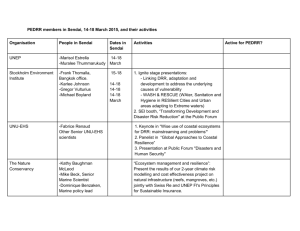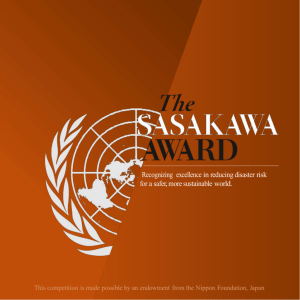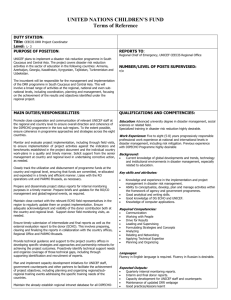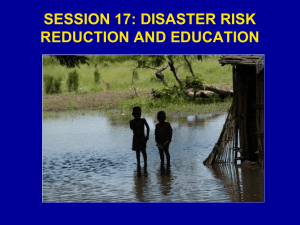ToR_-_Ecosystem_management_DRR_conference_-_FV_
advertisement
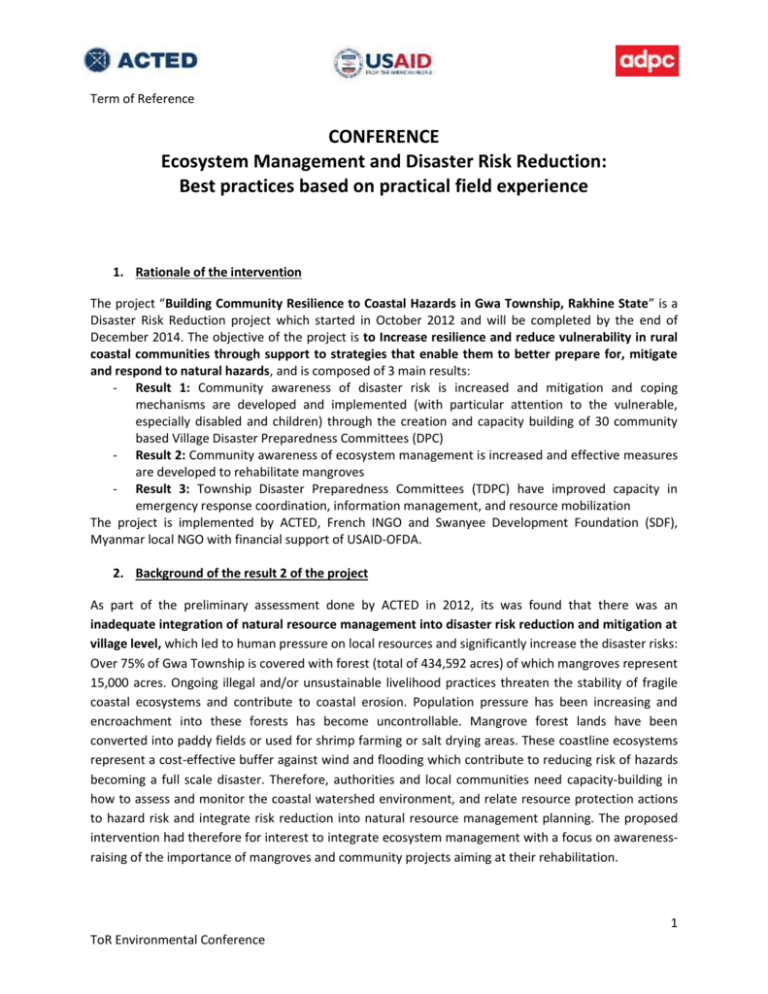
Term of Reference CONFERENCE Ecosystem Management and Disaster Risk Reduction: Best practices based on practical field experience 1. Rationale of the intervention The project “Building Community Resilience to Coastal Hazards in Gwa Township, Rakhine State” is a Disaster Risk Reduction project which started in October 2012 and will be completed by the end of December 2014. The objective of the project is to Increase resilience and reduce vulnerability in rural coastal communities through support to strategies that enable them to better prepare for, mitigate and respond to natural hazards, and is composed of 3 main results: - Result 1: Community awareness of disaster risk is increased and mitigation and coping mechanisms are developed and implemented (with particular attention to the vulnerable, especially disabled and children) through the creation and capacity building of 30 community based Village Disaster Preparedness Committees (DPC) - Result 2: Community awareness of ecosystem management is increased and effective measures are developed to rehabilitate mangroves - Result 3: Township Disaster Preparedness Committees (TDPC) have improved capacity in emergency response coordination, information management, and resource mobilization The project is implemented by ACTED, French INGO and Swanyee Development Foundation (SDF), Myanmar local NGO with financial support of USAID-OFDA. 2. Background of the result 2 of the project As part of the preliminary assessment done by ACTED in 2012, its was found that there was an inadequate integration of natural resource management into disaster risk reduction and mitigation at village level, which led to human pressure on local resources and significantly increase the disaster risks: Over 75% of Gwa Township is covered with forest (total of 434,592 acres) of which mangroves represent 15,000 acres. Ongoing illegal and/or unsustainable livelihood practices threaten the stability of fragile coastal ecosystems and contribute to coastal erosion. Population pressure has been increasing and encroachment into these forests has become uncontrollable. Mangrove forest lands have been converted into paddy fields or used for shrimp farming or salt drying areas. These coastline ecosystems represent a cost-effective buffer against wind and flooding which contribute to reducing risk of hazards becoming a full scale disaster. Therefore, authorities and local communities need capacity-building in how to assess and monitor the coastal watershed environment, and relate resource protection actions to hazard risk and integrate risk reduction into natural resource management planning. The proposed intervention had therefore for interest to integrate ecosystem management with a focus on awarenessraising of the importance of mangroves and community projects aiming at their rehabilitation. 1 ToR Environmental Conference As part of the results 2, activities have been undertaken to achieve the followings: - - - A comprehensive ecosystem report has been developed, as a result of a field assessment mission and academic review. The assessment highlights what environmental actions could be taken to improve and/ or restore the ecosystem in the area, particularly addressing DRR environmental considerations. Outcomes of the assessment and provision of report findings has been presented to the communities, local authorities and other relevant stakeholders to ensure appropriate awareness raising and related resource protection actions to hazard risks, and ultimately integrated into natural resource management planning and integrate risk reduction into natural resource management planning. The environmental management awareness raising has culminated in a call for proposals from all target villages, based on Village Disaster Contingency and Mitigation Plans. The DPC (Disaster Preparedness Committee’s) had to demonstrate support and input from villages authorities and community leaders, and proposed projects aimed at protecting and restoring environmental zones which coincide with high vulnerability areas to reduce that vulnerability. 12 micro projects were selected for a total amount of 55,000 USD, and covered trees and mangrove replanting. Some other micro-projects were covering the aspects of water access during disaster events through flood resistant wells, as well as improving access to identified safe areas through road rehabilitation. 3. Objectives of the conference The conference is organized jointly by ACTED and ADPC in Nai Pyi Taw and will aim to build consensus related to best practices across Myanmar for Disaster Risk Reduction and management of specific ecosystem (mangrove and forest). It will aim to bring together Government officials, Research and Environmental protection agencies, INGO’s and civil society to discuss the issues at stake for environmental protection, with the focus on the benefit of these to reduce disaster risks. The entry point of the conference will be the results of the DRR project in Myanmar, implemented by ACTED and Swanyee Development Foundation and founded by USAID-OFDA, while it will work in line with ADPC's 2020 strategy. The general objectives will be to identify best practices based on practical experience by a various range of stakeholders." To achieve this objective, academic researcher as well as active local environmental agencies (MERN, MEGA) working in Myanmar will be invited to join to share their recommendations, and present the outcomes of their project. Any development agency which is working on the aspect of DRR and ecosystem rehabilitation/conservation and who are willing to participate will be as well invited and share their thoughts/recommendations. 2 ToR Environmental Conference The objectives of the conference will aim to: Define the state of the degradation of the mangrove/forestry based on the last up to date research in Myanmar Present DRR and Ecosystem Management Awareness strategy in place by government/(I)NGO’s How mangrove can support innovative approach Understand linkages between Disaster Risk Reduction and environmental protection, mangrove and forestry rehabilitation Present recommendations based on recent practical experience implemented by DRR practitioners Reach an understanding and agreement on the best practices to be replicate based on these past experience, with commitment from stakeholders (local government and NGO’s) 4. Expected date – Agenda The conference is planned to be conducted on the 16th of December 2014 in Nay Pyi Taw (effective venue to be confirmed). Time 8:30-9:00 am 9:00-10:00 am 10:00-10:15 am 10.15-10.30 am 10:30-11:00 am 11.00-11.30 am 11:30-12:00 am 12:00-1:00 pm 1:00-1.30 pm Program Registration Opening Remark by Director General of Relief and Resettlement Department Remark by Director General of Ecosystem Conservation and Forestry Remark by ACTED Country Director Remark by ADPC Country Director Agenda presentation – Group Picture Coffee Break – Access to IEC materials exhibition USAID-OFDA Project Presentation Academic presentation – Degradation of mangrove and forest in Myanmar DRR and Ecosystem Protection Livelihood and Ecosystem Protection Lunch Break - Access to IEC materials exhibition National Biodiversity Strategy – MAPDRR : Contextualization of previous presentations into Myanmar institutional frameworks 1.30-3.15 pm DRR practitioners best practices 3:15-3:30 pm 3:30-4:30 pm Coffee Break - Access to IEC materials exhibition Open discussion on day learning and listing of key aspects for DRR and Ecosystem Rehabilitation Wrap up – recommendations and commitment ACTED Country director ADPC Country Manager Ministry of environment and forestry 4.30-5.00 pm MC/Facilitator ACTED administration MC ACTED FFI ADPC MERN Ministry of Environmental conservation and Forestry - RRD Local and International NGO’s – to be define MC MC 3 ToR Environmental Conference 5.00 pm Closing 5. Expected participants - Government: Ministry of environmental protection and forestry, RRD, Gwa Township authorities - Environmental agencies (local and International): FFI, MERN (Myanmar Ecosystem Rehabilitation Network) - DRR practitioners (International and local organization) - Institutional partners: OFDA – ECHO – UN - Journalists (Myanmar Times – others to be defined) 6. Communication strategy A space will be made available for Ecosystem conservation stakeholders to display awareness materials (leaflet/posters or handbooks) used to reach improve community’s knowledge and awareness on the importance of ecosystem protection, with linkage with Disaster Risk Reduction. Journalists will be attending the conference and insure participation visibility of the action. Press release to be provided beforehand to the journalists invited. 7. Expected outcomes of the conference Best practices will be shared and commitment reached on DRR and ecosystem rehabilitation Stakeholders will have a common understanding of DRR and ecosystem rehabilitation The networks of DRR practitioners is enhance, to ensure a potential joint collaboration in the future 8. Contacts ADPC - Angeliki Parasiraki, country manager Email: angeliki.p@adpc.net ACTED – Benoit Gerfault, DRR program coordinator Email: benoit.gerfault@acted.org 4 ToR Environmental Conference 5 ToR Environmental Conference




